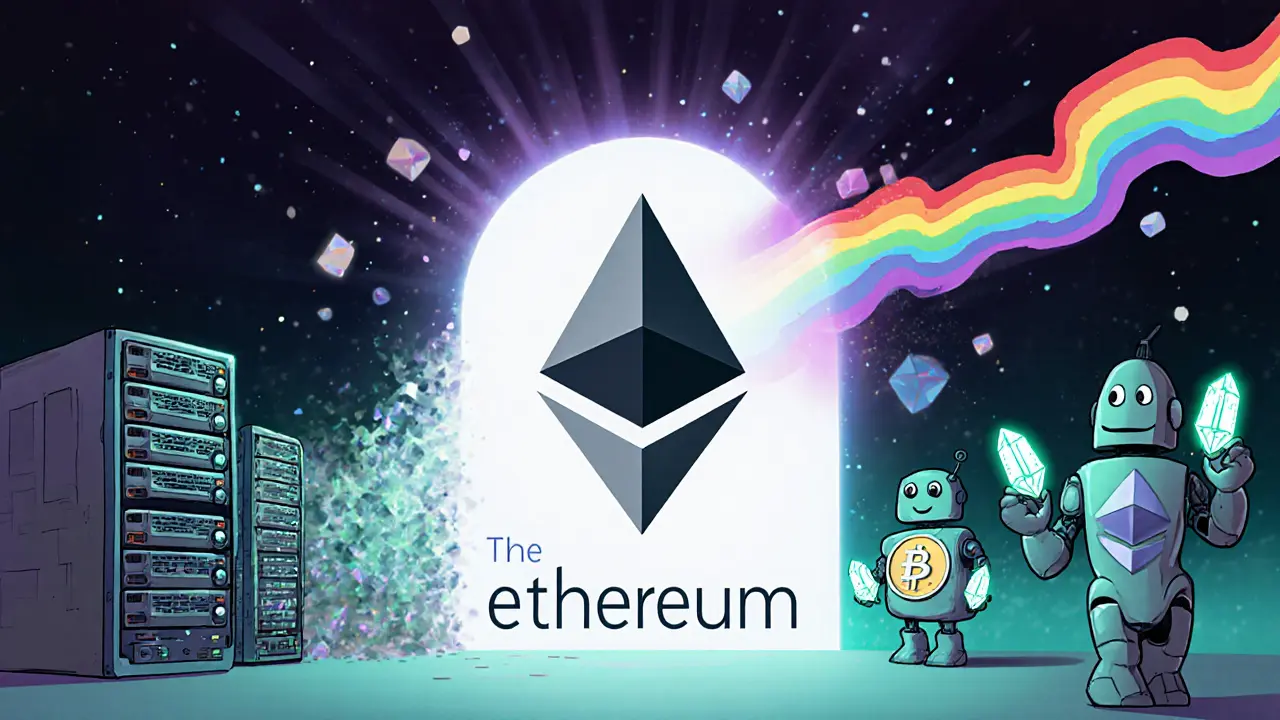 Aug, 27 2025
Aug, 27 2025
Ethereum Mining vs. Staking Cost Calculator
Results
When Ethereum switched from mining to staking, the whole crypto world felt the tremor. The change didn’t just flip a switch; it rewrote how security, rewards, and energy use work on the second‑largest blockchain. If you’ve been wondering why the shift matters, how it was done, and what it means for you, keep reading. This guide walks through the technical jump, the economics, and the practical steps you can take today.
What Ethereum Mining Looked Like
Ethereum started in 2015 as a Proof of Work (PoW) network. Miners used powerful GPU graphics cards to solve cryptographic puzzles, earning newly minted ETH and transaction fees. The process demanded rigs costing anywhere from $2,000 to $10,000, plus electricity bills of $200‑$500 per month, depending on local rates. The reward model was volatile because difficulty adjusted constantly, and miners faced hardware wear, heat, and noise.
Why the Shift Was Inevitable
Three pain points pushed the community toward a new model:
- Energy consumption - PoW drained more than 99% of the electricity that today’s Proof of Stake (PoS) uses.
- Scalability bottlenecks - Transaction throughput plateaued around 15‑30tps, while DeFi and NFTs surged.
- Regulatory pressure - Governments started flagging energy‑hungry mining as a climate concern.
The answer came in September 2022 with The Merge - the coordinated upgrade that retired PoW and activated PoS on the mainnet.
How Staking Works on Ethereum
In PoS, security comes from validators who lock up ETH as collateral. A validator is chosen to propose a block based on the size of its stake and a random selection algorithm. Once a block is proposed, other validators attest to its validity. Every “epoch” - roughly 6.4minutes - ends with rewards distributed for correct attestations.
Key parameters:
- Minimum solo stake: 32ETH (about $80k‑$120k at 2025 prices).
- Pool entry: as low as 0.01ETH on many services.
- Typical APY: 4‑7% for solo validators, 3.5‑6.5% for pooled or exchange‑based staking.
Because validators only need an internet‑connected computer, the hardware cost drops to essentially zero. The main expense is the capital locked in ETH.
Mining vs. Staking - Side‑by‑Side
| Aspect | Mining (PoW) | Staking (PoS) |
|---|---|---|
| Energy use | ~14TWh/year | ~0.2TWh/year (99% reduction) |
| Initial hardware cost | $2,000‑$10,000 for GPU rig | None (only ETH stake) |
| Ongoing costs | $200‑$500/month electricity | Minimal server/hosting fees ($5‑$10/month) |
| Reward model | Block reward + tx fees; volatile with difficulty | Fixed APY + tx fees; predictable |
| Barrier to entry | High technical skill, hardware maintenance | Low for pools; 32ETH for solo |
| Risk factors | Hardware failure, ASIC competition | Slashing (up to 5% of stake), lock‑up periods |

Getting Started with Ethereum Staking
Three main paths exist, each with a different time investment and skill requirement.
- Use a centralized exchange. Open an account on platforms like Gemini, Coinbase, or Binance. Deposit ETH, hit the “Stake” button, and watch rewards land automatically. Setup takes under 30 minutes for beginners.
- Join a staking pool. Services such as Lido let you stake as little as 0.01ETH. You receive a liquid token (stETH) that can be used in DeFi while your ETH is locked.
- Run a solo validator. Requires a Linux server, 32ETH, and constant uptime. Expect 20‑40hours of initial configuration, then regular monitoring (software updates, network health checks). Documentation is extensive but dense; community Discords help bridge gaps.
Choose the route that fits your technical comfort and capital availability.
Risks and Mitigations
Staking isn’t risk‑free. The biggest concerns are:
- Slashing. Misbehaving or going offline can burn up to 5% of your stake. Mitigate by using reliable hosting and setting up alerting tools.
- Liquidity lock‑up. Until the next withdrawal window (planned for 2024‑2025 upgrades), you can’t move your ETH. Pool tokens like stETH provide liquidity, though they may trade at a slight discount.
- Market volatility. Even a steady 5% APY can be eclipsed by ETH price swings. Diversify across assets if you’re risk‑averse.
Overall, most experts agree the risk‑adjusted return of staking beats traditional mining for the average user.
Current Landscape (2025 Snapshot)
As of October2025, more than $40billion worth of ETH is staked across validators and services. Over 500,000 individual validators protect the network, from solo operators to institutional nodes. Major exchanges report yields as follows:
- Gemini: 5.2% APY (solo‑validator style, no lock‑up)
- Coinbase: 4.8% APY (30‑day lock‑up)
- Binance: 5.0% APY (flexible)
- Kraken: 4.6% APY (30‑day lock‑up)
The shift has also eased regulatory scrutiny. Several jurisdictions now view PoS networks as “low‑impact” crypto, granting them clearer compliance pathways compared to energy‑heavy mining farms.

What’s Next for Ethereum Staking?
Three developments will shape the next few years:
- Sharding. The upcoming “Danksharding” upgrade will split the chain into multiple shards, allowing validators to run lighter nodes and further reduce hardware demands.
- Improved withdrawal mechanics. Recent client updates let validators exit with shorter notice periods, easing the liquidity concern.
- Cross‑chain staking. Bridges to other PoS chains (e.g., Polkadot, Solana) enable “restaking” of ETH on multiple networks, opening new yield opportunities.
These upgrades aim to make staking even more accessible and profitable, reinforcing the transition as a permanent change rather than a temporary experiment.
Quick Checklist for Switching from Mining to Staking
- Assess your ETH holdings - do you have 32ETH or will you join a pool?
- Choose a staking method - exchange, pool, or solo validator.
- Set up a secure wallet (e.g., Ledger, MetaMask) for ETH deposits.
- If running solo, provision a Linux server, install the
prysmorlodestarclient, and generate your validator keys. - Monitor performance - use Grafana dashboards or exchange alerts.
- Stay updated on protocol upgrades (sharding, withdrawal changes).
Frequently Asked Questions
Is staking really safer than mining?
For most users, yes. Staking removes hardware‑related failures and electricity costs. The main risk is slashing, which can be avoided with reliable uptime and using reputable pool operators.
Can I unstake my ETH whenever I want?
Not instantly. After signalling a withdrawal, the network enforces a delay (currently about 30 days) to protect consensus. Liquid staking tokens like stETH can be traded while you wait.
Do I need 32ETH to earn rewards?
Solo validation requires 32ETH, but many services let you stake fractions as low as 0.01ETH. You’ll receive a proportional share of rewards.
What happens to my mining hardware?
You can sell it, repurpose it for other GPU‑friendly coins (e.g., Ravencoin, Ethereum Classic), or keep it as a backup mining rig for future PoW projects.
Will staking yields stay the same?
Yields adjust with the total amount staked and network usage. Historically they’ve hovered between 4‑8% for ETH, but market conditions can push them higher or lower.
Jessica Cadis
August 27, 2025 AT 15:16Ethereum's shift to proof‑of‑stake isn’t just a protocol upgrade; it’s a cultural revolution that forces every participant to rethink how value is secured, and anyone still clinging to mining is living in the past.
Katharine Sipio
September 5, 2025 AT 21:30Thank you for this exhaustive guide. The clear, step‑by‑step explanations will undoubtedly assist many newcomers in navigating the staking process with confidence.
Shikhar Shukla
September 15, 2025 AT 03:43Although the article covers many aspects, it fails to address the centralisation risk posed by large staking pools, which could undermine the very decentralisation ethos Ethereum strives for.
Deepak Kumar
September 24, 2025 AT 09:56If you’re hesitant about staking, consider that running a solo validator not only earns you reliable rewards but also contributes directly to network security, turning you into an active guardian of the blockchain.
Matthew Theuma
October 3, 2025 AT 16:10Staking feels like a low‑key way to earn passive income, especially when you can just leave a tiny VPS running. 😊
Carolyn Pritchett
October 12, 2025 AT 22:23This guide is a waste of bandwidth; anyone serious about crypto would already know this junk.
Jason Zila
October 22, 2025 AT 04:36The upcoming Danksharding upgrade promises to reduce validator load dramatically, and I’m curious how this will affect APY calculations for pooled versus solo staking strategies in the next year.
lida norman
October 31, 2025 AT 09:50I totally get how intimidating the lock‑up period can seem 😢-but think of the long‑term security benefits and the peace of mind that comes from contributing to a greener network.
Miguel Terán
November 9, 2025 AT 16:03When Ethereum transitioned from proof‑of‑work to proof‑of‑stake, the entire ecosystem experienced a seismic shift that rippled through every layer of development, from low‑level client code to high‑level DeFi applications. The technical intricacies involved, such as the beacon chain's role in coordinating validator consensus, are often underappreciated by casual observers. Moreover, the economic incentives designed to reward honest behavior have been fine‑tuned to balance security with accessibility. Stakeholders must understand that the 32 ETH requirement for solo operation is not merely a barrier but also a signal of commitment to the network's health. However, the emergence of liquid staking derivatives like stETH has democratized participation, allowing even small holders to capture a share of the rewards. This democratization, while beneficial, introduces new vectors of risk, especially concerning the governance of pooled services. Furthermore, the environmental impact reduction-cutting energy consumption by over 99%-is a compelling narrative that aligns with global sustainability goals. Yet, it also raises questions about the future of GPU‑based mining farms and how they might repurpose their hardware. The community’s response to The Merge, spanning from enthusiastic adoption to cautious skepticism, underscores the diverse viewpoints that fuel ongoing discourse. From a technical standpoint, validators must maintain high‑uptime servers, implement robust monitoring, and stay updated with client releases to avoid slashing penalties. The slashing mechanism itself serves as a deterrent against malicious behavior, reinforcing the integrity of the consensus. On the macro level, the massive influx of staked ETH-now exceeding $40 billion-has solidified Ethereum's position as a cornerstone of the decentralized finance landscape. Looking ahead, the planned Danksharding upgrade promises to further scale transaction throughput, reducing the load on individual validators and making the network more resilient. In parallel, improvements to withdrawal mechanics aim to alleviate liquidity constraints, offering stakers greater flexibility. Lastly, cross‑chain staking initiatives hint at an era where assets can be restaked across multiple PoS networks, unlocking new yield opportunities while preserving security. All these developments converge to paint a picture of an ecosystem in constant evolution, where every participant plays a pivotal role in shaping the future.
Shivani Chauhan
November 18, 2025 AT 22:16Excellent breakdown, especially the section on upcoming sharding; staying informed will be crucial for anyone looking to optimise their staking strategy.
Deborah de Beurs
November 28, 2025 AT 04:30Honestly, if you’re still mining on legacy hardware you’re basically burning money on a dying dinosaur. No wonder you’re missing out on the massive efficiency gains from staking.
Sara Stewart
December 7, 2025 AT 10:43Leverage those validator rewards with yield‑optimisation strategies like restaking to maximize APR-stay ahead of the curve! By integrating cross‑chain staking, you can compound returns while contributing to broader network security.